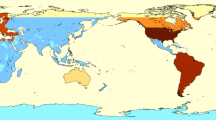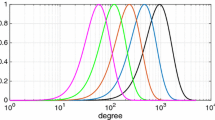Abstract
The issue of combining high-resolution gravity models, based on observations taken on the Earth surface, with those derived from satellite-only observations is of increasing importance, due to the new data provided by gravity satellite missions, CHAMP, GRACE and GOCE. The paper addresses this issue with a twofold purpose. On the one hand, it is an attempt to discuss and assess general concepts, well known in literature, such as achievable resolution, regularization in the least-squares sense or in an infinite dimensional setup, combination criteria, symmetry and block diagonal structures. In particular, as for the symmetry question, a well-defined result, generalizing known facts, is derived. On the other hand, the outcomes of the general discussion are specifically applied to the combination of a high-resolution model (e.g. EGM08) with a GOCE gravity model estimated by the so-called space-wise approach. Small numerical examples are developed to clarify the property of the proposed solution.
Similar content being viewed by others
References
Alkhatib H, Schuh W-D (2007) Integration of the Monte Carlo covariance estimation strategy into tailored solution procedures for large-scale least squares problems. J Geod 81(1): 53–66
Bosch W (1993) A rigorous least squares combination of low and high degree spherical harmonics. Presented at XXI IAG General Assembly, 8–15 August 1993, Beijing, China
Bouman J (2000) Quality assessment of satellite-based global gravity fields models. In: Publications on Geodesy, vol 48, The Netherlands Geodetic Commission, Delft
Boxhammer Ch, Schuh W-D (2006) GOCE gravity field modeling: computational aspects—free kite numbering scheme. In: Flury J, Rummel R, Reigber Ch, Rothacher M, Boedecker G, Schreiber U (eds) Observation of the Earth system from space. Springer, Berlin, pp 209–224
Catastini G, Cesare S, De Sanctis S, Dumontel M, Parisch M, Sechi G (2007) Predictions of the GOCE in-flight performances with the End-to-End System Simulator. In: Proceedings of the 3rd International GOCE User Workshop, 6–8 November 2006, Frascati, Italy, pp 9–16
Colombo OL (1981) Numerical methods for harmonic analysis on the sphere. Report No. 310, Department of Geodetic Science and Surveying, The Ohio State University, Columbus
Cox DR, Hinkley DV (1974) Theoretical statistics. Chapman and Hall, London
ESA (1999) Gravity field and steady-state ocean circulation mission. ESA SP-1233(1). ESA Publication Division, c/o ESTEC, Noordwijk
Gruber T (2001) High-resolution gravity field modeling with full variance-covariance matrices. J Geod 75(9–10): 505–514
Gundlich N, Koch K-R, Kusche J (2003) Gibbs sampler for computing and propagating large covariance matrices. J Geod 77(9): 514–528
Heiskanen WA, Moritz H (1967) Physical geodesy. WH Freeman and Co, San Francisco
Hestenes MR, Stiefel E (1952) Methods of conjugate gradients for solving linear systems. J Res Natl Bureau Stand 49(6): 409–436
Jekeli C (1999) The determination of gravitational potential differences from satellite-to-satellite tracking. Celest Mech Dyn Astron 75(2): 85–101
Kalman RE, Bucy RS (1961) New results in linear filtering and prediction theory. Trans ASME Ser D J Basic Eng 83: 95–107
Kaula WM (1966) Tests and combination of satellite determinations of the gravity field with gravimetry. J Geophys Res 71(22): 5303–5314
Kaula WM (1966) Theory of satellite geodesy. Blaisdell Publishing Company, Waltham
Kirsch A (1996) An introduction to the matematical theory of inverse problems. In: Applied Mathematical Sciences, vol 120. Springer, Berlin
Klees R, Ditmar P, Kusche J (2004) Numerical techniques for large least-squares problems with applications to GOCE. In: Sansò F (ed) International Association of Geodesy symposia, “V Hotine-Marussi Symposium on Mathematical Geodesy”, vol 127. Springer, Berlin, pp 12–21
Koch K-R (1999) Parameter estimation and hypothesis testing in linear models, 2nd edn. Springer, Berlin
Koch K-R, Kusche J (2002) Regularization of geopotential determination from satellite data by variance components. J Geod 76(5): 259–268
Koch K-R (2005) Determining the maximum degree of harmonic coefficients in geopotential models by Monte Carlo methods. Studia Geophysica et Geodaetica 49(3): 256–275
Krarup T (2006) A convergence problem in collocation theory. In: Borre K (ed) Mathematical foundation of geodesy. Springer, Berlin
Lemoine FG, Kenyon SC, Factor JK, Trimmer RG, Pavlis NK, Chinn DS, Cox CM, Klosko SM, Luthcke SB, Torrence MH, Wang YM, Williamson RG, Pavlis EC, Rapp RH, Olson TR (1998) The development of the joint NASA GSFC and NIMA geopotential model EGM96. NASA/TP-1998-206861, Goddard Space Flight Center, Greenbelt, Maryland
Mayer-Gürr T (2006) Gravitationsfeldbestimmung aus der Analyse kurzer Bahnbögen am Beispiel der Satellitenmissionen CHAMP und GRACE. PhD thesis, University of Bonn, Germany
Migliaccio F, Reguzzoni M, Sansò F (2004) Space-wise approach to satellite gravity field determination in the presence of coloured noise. J Geod 78(4–5): 304–313
Migliaccio F, Reguzzoni M, Sansò F, Tselfes N (2009) An error model for the GOCE space-wise solution by Montecarlo methods. In: Sideris MG (ed) International Association of Geodesy symposia, “Observing our Changing Earth”, vol 133. Springer, Berlin, pp 337–344
Moritz H (1989) Advanced physical geodesy, 2nd edn. Wichmann Verlag, Karlsruhe
Nikiforov AF, Uvarov VB (1988) Special functions of mathematical physics. Birkhäuser, Basel-Boston
Pail R, Bruinsma S, Migliaccio F, Förste C, Goiginger H, Schuh W-D, Hoeck E, Reguzzoni M, Brockmann JM, Abrikosov O, Veicherts M, Fecher T, Mayrhofer R, Krasbutter I, Sansò F, Tscherning CC (2011) First GOCE gravity field models derived by three different approaches. J Geod 85(11): 819–843
Papoulis A (1984) Signal analysis. McGraw Hill, New York
Pavlis NK (1997) Development and applications of geopotential models. In: Lecture notes of the international school for the determination and use of the geoid, International Geoid Service, DIIAR—Politecnico di Milano, pp 101–147
Pavlis NK, Holmes SA, Kenyon SC, Factor JK (2008) An Earth gravitational model to degree 2160: EGM2008. Presented at the 2008 General Assembly of the European Geophysical Union (EGU), pp 13–18 April 2008, Vienna
Pertusini L, Reguzzoni M, Sansò F (2010) Analysis of the covariance structure of the GOCE space-wise solution with possible applications. In: Mertikas SP (ed) International Association of Geodesy symposia, “Gravity, Geoid and Earth Observation”, vol 135. Springer-Verlag, Berlin, pp 95–202
Phillips DL (1962) A technique for the numerical solution of certain integral equations of the first kind. J Assoc Comput Mach 9: 84–97
Rao CR, Toutenburg H, Shalabh , Heumann C (2008) Linear models and generalizations, 3rd edn. Springer, Berlin
Rapp RH (1975) Comparison of least squares and collocation estimated from potential coefficients. In: Methoden und Verfahren der Mathematischen Physik, Band 14, Bibliographisches Institut, Zürich, pp 133–148
Rapp RH (1984) The determination of high degree potential coefficient expansions from the combination of satellite and terrestrial gravity information. Report No. 361, Department of Geodetic Science and Surveying, The Ohio State University, Columbus
Rapp RH (1994) The use of potential coefficient models in computing geoid undulations. In: Lecture notes of the international school for the determination and use of the geoid, International Geoid Service, DIIAR—Politecnico di Milano, pp 71–99
Reguzzoni M, Tselfes N (2009) Optimal multi-step collocation: application to the space-wise approach for GOCE data analysis. J Geod 83(1): 13–29
Reigber Ch, Schmidt R, Flechtner F, König R, Meyer U, Neumayer KH, Schwintzer P, Zhu SY (2005) An Earth gravity field model complete to degree and order 150 from GRACE: EIGEN-GRACE02S. J Geodyn 39(1): 1–10
Rummel R (1997) Spherical spectral properties of the Earth’s gravitational potential and its first and second derivatives. In: Sansò F, Rummel R (eds) Lecture notes in Earth sciences, “Geodetic Boundary Value Problems in View of the One Centimeter Geoid”, vol 65. Springer, Berlin, pp 359–404
Sansò F (1986) Statistical methods in physical geodesy. In: Sünkel H (ed) Lecture notes in Earth sciences, “Mathematical and Numerical Techniques in Physical Geodesy”, vol 7. Springer, Berlin, pp 49–155
Sansò F, Venuti G, Tscherning CC (2000) A theorem of insensitivity of the collocation solution to variations of the metric of the interpolation space. In: Schwarz KP (ed) International Association of Geodesy symposia, vol 121. Springer, Berlin, pp 233–240
Sansò F, Tscherning CC (2003) Fast spherical collocation: theory and examples. J Geod 77(1–2): 101–112
Schuh W-D (1996) Tailored numerical solution strategies for the global determination of the Earth’s gravity field. Mitteilungen der Geodätischen Institute der TU Graz, Folge 81, Graz
Sneeuw N (2000) A semi-analytical approach to gravity field analysis from satellite observations. Deutsche Geodätische Kommission, Reihe C, No. 527, Verlag der Bayerischen Akademie der Wissenschaften, München
Tapley BD, Shum CK, Ries JC, Poole SR, Abusali PAM, Bettadpur SV, Eanes RJ, Kim MC, Rim HJ, Shutz BE (1997) The TEG-3 Geopotential Model. In: Segawa J, Fujimoto H, Okubo S (eds) International Association of Geodesy symposium, “Gravity, Geoid, and Marine Geodesy”, vol 117. Springer, Berlin, pp 453–460
Tikhonov AN (1963) Regularization of incorrectly posed problems. Sov Math Doklady 4(6): 1624–1627
Tscherning CC, Rapp RH (1974) Closed covariance expressions for gravity anomalies, geoid undulations, and deflections of the vertical implied by anomaly degree-variance models. Report No. 208, Department of Geodetic Science, The Ohio State University, Columbus
Visser PNAM, Sneeuw N, Gerlach C (2003) Energy integral method for gravity field determination from satellite orbit coordinates. J Geod 77(3–4): 207–216
Author information
Authors and Affiliations
Corresponding author
Rights and permissions
About this article
Cite this article
Reguzzoni, M., Sansò, F. On the combination of high-resolution and satellite-only global gravity models. J Geod 86, 393–408 (2012). https://doi.org/10.1007/s00190-011-0526-3
Received:
Accepted:
Published:
Issue Date:
DOI: https://doi.org/10.1007/s00190-011-0526-3




